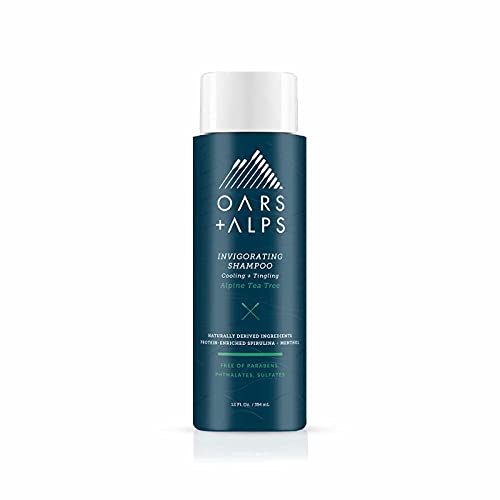
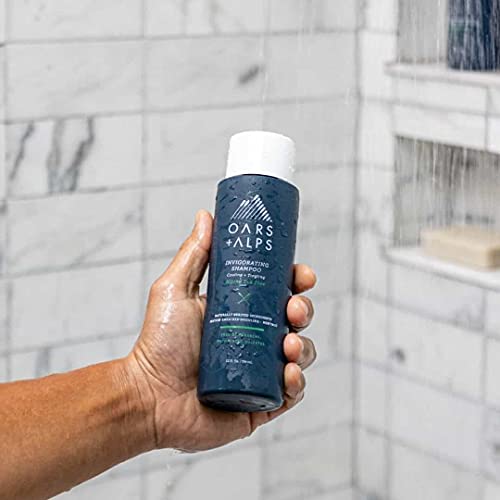
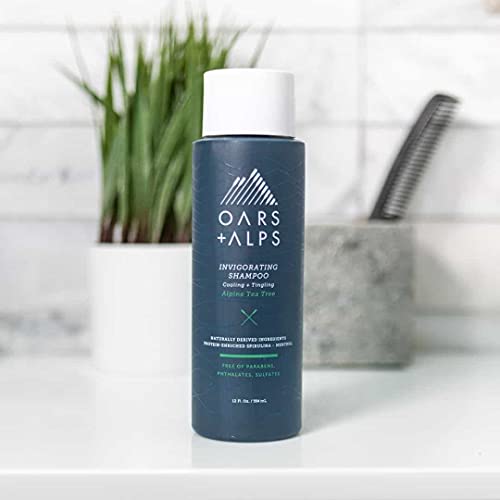
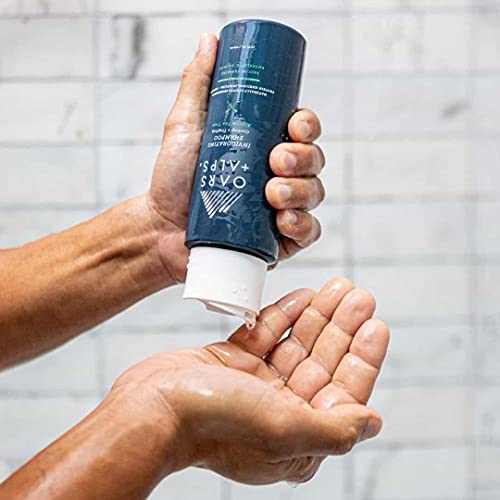
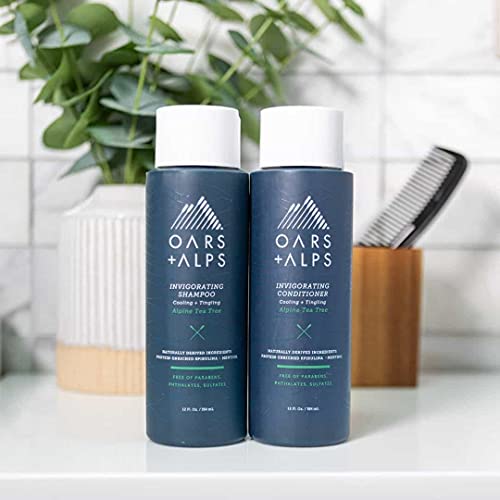
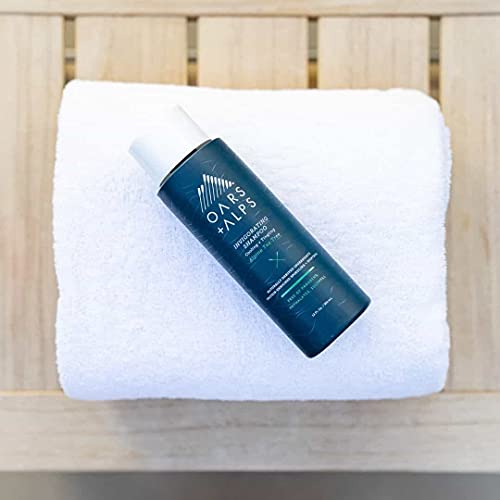
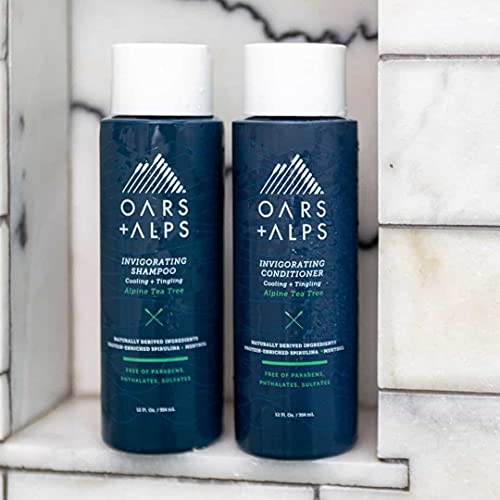
Oars + Alps Men's Shampoo - Soothes Scalp, Hydrates Hair with Witch Hazel & Tea Tree Oil - 12 Fl Oz


Cocamidopropyl Betaine
High RiskCocamidopropyl betaine is a synthetic surfactant derived from coconut oil, commonly used in personal care products for its mild cleansing and foaming properties. It functions as a surfactant, emulsifier, and thickening agent, contributing to the texture and performance of formulations.
Sustai Insights
Cocamidopropyl betaine offers functional benefits as a gentle surfactant, enhancing product foaming and texture. However, it may pose low to moderate allergenic risks and is subject to high use restrictions due to contamination concerns. Regulatory bodies have advised on its safe levels of usage, categorizing its risk level as high overall. Users should practice caution, particularly with sensitive populations, and consider alternatives like naturally derived surfactants for safer formulations.
Fragrance
High RiskFragrance refers to a mixture of aromatic compounds used in products to provide scent. It is commonly listed as 'fragrance' or 'parfum' on product labels and can serve various functions, including enhancing user experience and masking undesirable odors.
Sustai Insights
Fragrance offers functional benefits by improving product appeal; however, it poses significant health risks, notably a high likelihood of causing allergies and allergic contact dermatitis. Environmental risks include potential pollution and endocrine disruption, though its overall carcinogenicity is low. Regulatory bodies have noted concerns regarding its use, leading to a high-risk classification. Safe usage practices should be observed, and alternatives such as natural essential oils are recommended for those sensitive to synthetic fragrances.
Spirulina Maxima (Algae) Extract
Medium RiskSpirulina maxima extract is an extract of the blue-green algae Spirulina maxima, commonly used in dietary supplements and cosmetics for its nutritional properties and potential skin benefits. It is rich in proteins, vitamins, and antioxidants, contributing to its functional applications in various formulations.
Sustai Insights
Spirulina maxima extract offers functional benefits, including nutritional support and antioxidant properties, making it popular in health products. It is recognized for being sustainably sourced and biodegradable. Health risks are minimal, with low concerns for carcinogenicity, allergies, and reproductive toxicity; however, contamination concerns persist. Regulatory bodies do not impose significant restrictions, indicating moderate risk overall. Safe usage practices are recommended, and alternatives include other algae extracts or plant-based ingredients.
Peg 6 Sorbitan Oleate
Medium RiskPEG-6 Sorbitan Oleate is an ethoxylated sorbitan ester derived from sorbitol and oleic acid. It functions primarily as an emulsifier, helping to blend oil and water in various formulations, and is commonly used in personal care and cosmetic products.
Sustai Insights
PEG-6 Sorbitan Oleate offers effective emulsification properties, enhancing product texture and stability. It is generally considered to have low carcinogenicity and developmental toxicity, while moderate concerns exist regarding allergies and immunotoxicity. Contamination risks are notable. This ingredient is subject to regulatory restrictions and should be used cautiously, particularly for sensitive populations. Alternatives include natural emulsifiers such as beeswax or lecithin. The overall risk assessment is moderate.
Sodium Benzoate
Medium RiskSodium benzoate is a preservative commonly used in food and cosmetic products to prevent microbial growth and extend shelf life. It is derived from benzoic acid and is effective at low concentrations, often used in acidic environments like beverages and condiments.
Sustai Insights
Sodium benzoate serves effectively as a preservative, contributing to product stability and safety. It is generally recognized as safe with low concerns for carcinogenicity, allergies, and reproductive toxicity, though it faces moderate use restrictions in some regions. Environmental risks include its potential as a pollutant, but it does not bioaccumulate significantly. Regulatory bodies have issued advisories regarding its concentration in products. Overall, the risk level is assessed as medium, with safe usage practices recommended. Alternatives such as potassium sorbate may provide similar benefits with potentially lower restrictions.
Potassium Sorbate
Medium RiskPotassium sorbate is a potassium salt of sorbic acid, primarily used as a preservative in food and cosmetic products. It inhibits the growth of molds, yeast, and some bacteria, extending the shelf life of products. It is commonly found in various formulations due to its effectiveness and low toxicity.
Sustai Insights
Potassium sorbate serves as an effective preservative, preventing microbial growth in food and cosmetic products, which is vital for safety and longevity. Although it has a low risk of carcinogenicity and developmental toxicity, there is a moderate concern regarding allergies and immunotoxicity. Environmentally, it poses minimal risks as it is not significantly bioaccumulative. Regulatory agencies have verified its use, although some products may face restrictions. Overall, it is assessed as a medium risk ingredient, with safe usage practices recommended, and alternatives such as natural preservatives could be considered.
Citric Acid
Medium RiskCitric acid is an alpha hydroxy acid used in personal care products primarily for its role as a pH adjuster and natural preservative. It occurs naturally in citrus fruits and is commonly utilized in various formulations for its chelating properties and mild exfoliation benefits.
Sustai Insights
Citric acid offers functional benefits as an effective preservative and pH stabilizer, contributing to product longevity and stability. It is biodegradable and derived from renewable sources. Health risks are low, with minimal concerns regarding carcinogenicity, allergies, and reproductive toxicity. However, moderate use restrictions exist due to potential irritation at high concentrations. Environmental risks are limited, as citric acid is not known to accumulate in ecosystems. Regulatory agencies have no significant advisories against its use. Overall, it is assessed as a medium-risk ingredient, with safe usage practices recommended and alternatives available.
Vegetarian Glycerin
Low RiskVegetarian glycerin, also known as glycerol, is a colorless, odorless, and viscous liquid derived from plant sources. It is primarily used as a humectant, solvent, and emollient in various personal care products, helping to retain moisture and improve texture.
Sustai Insights
Vegetarian glycerin offers functional benefits as an effective humectant, promoting hydration and skin smoothness. It is biodegradable and typically sustainably sourced. Health risks associated with glycerin are low, with no significant concerns for carcinogenicity, allergens, or reproductive toxicity. Environmental risks are minimal, and it is not subject to major regulatory warnings. Overall, the risk level for this ingredient is low, making it a safe choice in formulations. Safe usage practices include ensuring proper concentrations in products, and alternatives such as propylene glycol exist but may have differing properties.
Water
Low RiskWater is a clear, colorless liquid essential for various biological processes. It serves as a solvent in formulations, facilitating the dissolution of other ingredients and enhancing product texture and application. Additionally, water plays a crucial role in hydration and is a key component in many cosmetic and personal care products.
Sustai Insights
Water is an effective solvent and hydrator, contributing to the texture and efficacy of formulations. It is biodegradable and generally regarded as safe, with low concerns regarding carcinogenicity, allergies, and reproductive toxicity. However, excessive water usage can lead to environmental concerns, particularly regarding resource depletion. Regulatory bodies do not impose restrictions on water use in cosmetics. Overall, the risks associated with water are low, making it a safe and essential ingredient.
Sodium Cocoyl Glutamate
Low RiskSodium cocoyl glutamate is a sodium salt of glutamic acid, derived from coconut oil. It serves primarily as a surfactant and mild cleansing agent in cosmetic formulations, contributing to the product's ability to remove dirt and oil while being gentle on the skin.
Sustai Insights
Sodium cocoyl glutamate offers functional benefits as a surfactant, enhancing cleansing efficacy without excessive irritation. It is considered low risk regarding health concerns, including carcinogenicity and allergenic potential. Regulatory assessments indicate no significant environmental hazards or restrictions. Overall, it is a low-risk ingredient, suitable for use in personal care products, with no notable adverse effects or regulatory warnings.
Sorbitan Laurate
Low RiskSorbitan laurate is a monoester of lauric acid and sorbitol. It is commonly used as an emulsifier and surfactant in cosmetic formulations, aiding in the mixing of oil and water components, and enhancing the texture and stability of products.
Sustai Insights
Sorbitan laurate effectively functions as an emulsifier, stabilizing formulations and improving texture. It is considered low risk for health concerns such as cancer, allergies, and reproductive toxicity, with no current restrictions from regulatory bodies. Environmentally, it poses minimal hazards, as it is not bioaccumulative or a significant pollutant. Safe usage practices should be followed, and while there are alternatives, sorbitan laurate remains a low-risk option in cosmetic applications.
Neomenthol
Low RiskNeomenthol is a menthol derivative commonly used for its cooling sensation in cosmetic and topical formulations. It acts primarily as a fragrance component and a soothing agent, contributing to the sensory attributes of products such as creams and ointments.
Sustai Insights
Neomenthol offers functional benefits, including its cooling effect and soothing properties in topical applications. It is not associated with significant health risks, as concerns regarding carcinogenicity, allergies, and toxicity are low. Environmentally, it poses minimal risks and is not classified as a pollutant. Regulatory status indicates no current restrictions. Overall, its risk level is assessed as low, making it a safe option for use in personal care products.
Sodium Gluconate
Low RiskSodium gluconate is a sodium salt of gluconic acid, commonly used as a chelating agent in various personal care products. It functions primarily to bind metal ions, enhancing product stability and efficacy. Additionally, it may serve as a moisturizer and skin conditioning agent.
Sustai Insights
Sodium gluconate is valued for its functional benefits, including effective chelation and moisture retention, contributing positively to product performance. It is considered low risk concerning health impacts, with minimal concerns regarding carcinogenicity, allergies, or reproductive toxicity. Environmental assessments indicate low pollutant potential and minimal bioaccumulation. Regulatory bodies have not imposed significant restrictions. Safe usage practices are advised, particularly regarding enhanced skin absorption. Overall, sodium gluconate presents a low risk profile, making it a viable choice in personal care formulations.
Apple Cider Vinegar
Low RiskApple cider vinegar is a fermented liquid made from crushed apples and is commonly used in food for flavoring, as a preservative, and in cleaning products due to its antibacterial properties. It is widely recognized for its culinary applications and potential health benefits.
Sustai Insights
Apple cider vinegar serves effectively as a preservative and flavoring agent, with some sustainability benefits due to its biodegradable nature. Health risks are minimal, with low concerns for carcinogenicity, allergies, and reproductive toxicity. It poses low environmental risks and is not currently restricted by regulatory bodies. Overall, it is considered a low-risk ingredient. For those seeking alternatives, other vinegar types or natural preservatives may be appropriate.
Polyquaternium 73
Low RiskPolyquaternium-73 is a synthetic polymer commonly used in cosmetic formulations as a conditioning agent and film-former. It enhances the texture and feel of hair and skin products, providing a smooth finish and improved manageability. Its functions include reducing static and enhancing moisture retention.
Sustai Insights
Polyquaternium-73 offers effective conditioning benefits, improving the performance of cosmetic products. It is regarded as low risk for cancer, allergies, and developmental toxicity, with no significant environmental hazard reported. Regulatory bodies have not flagged it for restriction. Safe usage practices should be followed, and while alternatives exist, they may not provide the same functional benefits. Overall, the assessment indicates a low risk associated with this ingredient.
Hamamelis Virginiana (Witch Hazel) Leaf Extract
Low RiskHamamelis virginiana (witch hazel) leaf extract is derived from the leaves of the witch hazel plant. It is commonly used in cosmetic formulations for its astringent properties, helping to tighten and tone the skin. This extract is often included in products designed for skin care, particularly for soothing minor skin irritations.
Sustai Insights
Hamamelis virginiana leaf extract offers functional benefits as an astringent, which can help reduce skin inflammation and improve skin appearance. It is generally regarded as safe with low risk of health concerns, including carcinogenicity and allergenic potential. Environmental impacts are minimal, and it is not bioaccumulative. Regulatory bodies impose few restrictions, reflecting its acceptance in cosmetic formulations. Safe usage practices should be followed, and alternatives like green tea extract may provide similar benefits with enhanced antioxidant properties. Overall, the risk level associated with this ingredient is low.
Decyl Glucoside
Low RiskDecyl glucoside is a glucose-based surfactant derived from natural sources, primarily used as a mild cleansing agent in personal care products. It effectively reduces surface tension, allowing for improved mixing of ingredients and enhanced cleansing properties without stripping natural oils from the skin.
Sustai Insights
Decyl glucoside offers functional benefits as a non-ionic surfactant, making it suitable for sensitive skin formulations. It is biodegradable and derived from renewable resources, supporting sustainability. Health risks are primarily low, with minimal concerns regarding irritation and allergies. Environmental risks are low, as it does not significantly contribute to pollution or bioaccumulation. Regulatory status is generally favorable, with low restrictions noted. Overall, decyl glucoside presents a low risk for use in consumer products, making it a suitable choice for gentle formulations.
Cocamide Mipa
Low RiskCocamide MIPA is a mixture of isopropanolamide derived from coconut fatty acids. It serves primarily as a surfactant and emulsifying agent in cosmetic formulations, contributing to the texture and stability of products such as shampoos and cleansers.
Sustai Insights
Cocamide MIPA offers functional benefits as a surfactant, enhancing product performance and texture. It is considered low risk for health concerns, with minimal irritation potential, and low environmental impact. Regulatory bodies have not imposed significant restrictions, indicating a favorable safety profile. Safe usage practices should be followed, and while alternatives exist, Cocamide MIPA's overall risk assessment remains low.
Cocamidopropyl Hydroxysultaine
Low RiskCocamidopropyl hydroxysultaine is a synthetic skin and hair conditioning agent commonly used in personal care products. It functions primarily as a surfactant, providing foaming and emulsifying properties, while also contributing to the conditioning of hair and skin.
Sustai Insights
Cocamidopropyl hydroxysultaine offers functional benefits as a mild surfactant and conditioning agent, with low concerns regarding carcinogenicity, allergies, and reproductive toxicity. It is generally regarded as safe with low irritation potential. Environmental assessments indicate low pollutant potential and minimal bioaccumulation. Regulatory bodies have not imposed significant restrictions on its use, aligning with low risk levels overall. Safe usage is advised, particularly for sensitive populations, and alternative gentle surfactants may be considered for those seeking greener options. In conclusion, this ingredient is classified as low risk.
Sorbeth 230 Tetraoleate
Low RiskSorbeth 230 tetraoleate is a nonionic surfactant commonly used in cosmetic formulations as an emulsifier and stabilizer. It aids in blending oil and water components, enhancing texture and consistency in various products.
Sustai Insights
Sorbeth 230 tetraoleate provides effective emulsification, improving product stability and texture. Its risk profile indicates low concerns regarding carcinogenicity, allergies, and reproductive toxicity, although contamination risks are noted. Regulatory assessments show no significant restrictions. Environmental impacts appear minimal, with low bioaccumulation potential. Safe usage practices should be observed, and while no direct alternatives are specified, evaluating greener emulsifiers may be beneficial. Overall, the ingredient is assessed as low risk.
Mentha Piperita (Peppermint) Oil Extract
Low RiskMentha piperita (peppermint) oil extract is derived from the peppermint plant and is commonly used in various products for its aromatic and flavoring properties. It serves multiple functions, including acting as a fragrance agent and providing a cooling sensation in topical applications.
Sustai Insights
Mentha piperita oil offers functional benefits such as flavor enhancement and a refreshing aroma, while it is generally recognized as low risk for health concerns, including carcinogenicity and allergies. Environmentally, it does not contribute significantly to pollution or bioaccumulation. Regulatory bodies do not impose restrictions on its use. Safe usage practices include avoiding excessive exposure, particularly for sensitive individuals. Alternatives like spearmint oil may be considered, but overall, this ingredient is assessed as low risk.
Melaleuca Alternifolia (Tea Tree)
Low RiskMelaleuca alternifolia, commonly known as tea tree, is an unspecified preparation derived from the leaves of the tea tree. It is primarily used for its antiseptic properties and is found in various personal care products.
Sustai Insights
Tea tree oil offers functional benefits such as antimicrobial properties, making it effective in skincare formulations. It is considered to have low health risks, including low concerns for carcinogenicity, allergies, and reproductive toxicity. Environmental risks are minimal, with no significant pollutant or bioaccumulation potential. Regulatory bodies have noted no major advisories, and overall risk assessment remains low. For safe usage, it is recommended to use appropriate concentrations and consider alternatives like lavender or eucalyptus oil for similar benefits.
Vegetarian Glycerin
Low RiskVegetarian glycerin, also known as glycerol, is a colorless, odorless, and viscous liquid derived from plant sources. It is primarily used as a humectant, solvent, and emollient in various personal care products, helping to retain moisture and improve texture.
Sustai Insights
Vegetarian glycerin offers functional benefits as an effective humectant, promoting hydration and skin smoothness. It is biodegradable and typically sustainably sourced. Health risks associated with glycerin are low, with no significant concerns for carcinogenicity, allergens, or reproductive toxicity. Environmental risks are minimal, and it is not subject to major regulatory warnings. Overall, the risk level for this ingredient is low, making it a safe choice in formulations. Safe usage practices include ensuring proper concentrations in products, and alternatives such as propylene glycol exist but may have differing properties.
Water
Low RiskWater is a clear, colorless liquid essential for various biological processes. It serves as a solvent in formulations, facilitating the dissolution of other ingredients and enhancing product texture and application. Additionally, water plays a crucial role in hydration and is a key component in many cosmetic and personal care products.
Sustai Insights
Water is an effective solvent and hydrator, contributing to the texture and efficacy of formulations. It is biodegradable and generally regarded as safe, with low concerns regarding carcinogenicity, allergies, and reproductive toxicity. However, excessive water usage can lead to environmental concerns, particularly regarding resource depletion. Regulatory bodies do not impose restrictions on water use in cosmetics. Overall, the risks associated with water are low, making it a safe and essential ingredient.
Sodium Cocoyl Glutamate
Low RiskSodium cocoyl glutamate is a sodium salt of glutamic acid, derived from coconut oil. It serves primarily as a surfactant and mild cleansing agent in cosmetic formulations, contributing to the product's ability to remove dirt and oil while being gentle on the skin.
Sustai Insights
Sodium cocoyl glutamate offers functional benefits as a surfactant, enhancing cleansing efficacy without excessive irritation. It is considered low risk regarding health concerns, including carcinogenicity and allergenic potential. Regulatory assessments indicate no significant environmental hazards or restrictions. Overall, it is a low-risk ingredient, suitable for use in personal care products, with no notable adverse effects or regulatory warnings.
Sorbitan Laurate
Low RiskSorbitan laurate is a monoester of lauric acid and sorbitol. It is commonly used as an emulsifier and surfactant in cosmetic formulations, aiding in the mixing of oil and water components, and enhancing the texture and stability of products.
Sustai Insights
Sorbitan laurate effectively functions as an emulsifier, stabilizing formulations and improving texture. It is considered low risk for health concerns such as cancer, allergies, and reproductive toxicity, with no current restrictions from regulatory bodies. Environmentally, it poses minimal hazards, as it is not bioaccumulative or a significant pollutant. Safe usage practices should be followed, and while there are alternatives, sorbitan laurate remains a low-risk option in cosmetic applications.
Spirulina Maxima (Algae) Extract
Medium RiskSpirulina maxima extract is an extract of the blue-green algae Spirulina maxima, commonly used in dietary supplements and cosmetics for its nutritional properties and potential skin benefits. It is rich in proteins, vitamins, and antioxidants, contributing to its functional applications in various formulations.
Sustai Insights
Spirulina maxima extract offers functional benefits, including nutritional support and antioxidant properties, making it popular in health products. It is recognized for being sustainably sourced and biodegradable. Health risks are minimal, with low concerns for carcinogenicity, allergies, and reproductive toxicity; however, contamination concerns persist. Regulatory bodies do not impose significant restrictions, indicating moderate risk overall. Safe usage practices are recommended, and alternatives include other algae extracts or plant-based ingredients.
Neomenthol
Low RiskNeomenthol is a menthol derivative commonly used for its cooling sensation in cosmetic and topical formulations. It acts primarily as a fragrance component and a soothing agent, contributing to the sensory attributes of products such as creams and ointments.
Sustai Insights
Neomenthol offers functional benefits, including its cooling effect and soothing properties in topical applications. It is not associated with significant health risks, as concerns regarding carcinogenicity, allergies, and toxicity are low. Environmentally, it poses minimal risks and is not classified as a pollutant. Regulatory status indicates no current restrictions. Overall, its risk level is assessed as low, making it a safe option for use in personal care products.
Cocamidopropyl Betaine
High RiskCocamidopropyl betaine is a synthetic surfactant derived from coconut oil, commonly used in personal care products for its mild cleansing and foaming properties. It functions as a surfactant, emulsifier, and thickening agent, contributing to the texture and performance of formulations.
Sustai Insights
Cocamidopropyl betaine offers functional benefits as a gentle surfactant, enhancing product foaming and texture. However, it may pose low to moderate allergenic risks and is subject to high use restrictions due to contamination concerns. Regulatory bodies have advised on its safe levels of usage, categorizing its risk level as high overall. Users should practice caution, particularly with sensitive populations, and consider alternatives like naturally derived surfactants for safer formulations.
Peg 6 Sorbitan Oleate
Medium RiskPEG-6 Sorbitan Oleate is an ethoxylated sorbitan ester derived from sorbitol and oleic acid. It functions primarily as an emulsifier, helping to blend oil and water in various formulations, and is commonly used in personal care and cosmetic products.
Sustai Insights
PEG-6 Sorbitan Oleate offers effective emulsification properties, enhancing product texture and stability. It is generally considered to have low carcinogenicity and developmental toxicity, while moderate concerns exist regarding allergies and immunotoxicity. Contamination risks are notable. This ingredient is subject to regulatory restrictions and should be used cautiously, particularly for sensitive populations. Alternatives include natural emulsifiers such as beeswax or lecithin. The overall risk assessment is moderate.
Sodium Gluconate
Low RiskSodium gluconate is a sodium salt of gluconic acid, commonly used as a chelating agent in various personal care products. It functions primarily to bind metal ions, enhancing product stability and efficacy. Additionally, it may serve as a moisturizer and skin conditioning agent.
Sustai Insights
Sodium gluconate is valued for its functional benefits, including effective chelation and moisture retention, contributing positively to product performance. It is considered low risk concerning health impacts, with minimal concerns regarding carcinogenicity, allergies, or reproductive toxicity. Environmental assessments indicate low pollutant potential and minimal bioaccumulation. Regulatory bodies have not imposed significant restrictions. Safe usage practices are advised, particularly regarding enhanced skin absorption. Overall, sodium gluconate presents a low risk profile, making it a viable choice in personal care formulations.
Sodium Benzoate
Medium RiskSodium benzoate is a preservative commonly used in food and cosmetic products to prevent microbial growth and extend shelf life. It is derived from benzoic acid and is effective at low concentrations, often used in acidic environments like beverages and condiments.
Sustai Insights
Sodium benzoate serves effectively as a preservative, contributing to product stability and safety. It is generally recognized as safe with low concerns for carcinogenicity, allergies, and reproductive toxicity, though it faces moderate use restrictions in some regions. Environmental risks include its potential as a pollutant, but it does not bioaccumulate significantly. Regulatory bodies have issued advisories regarding its concentration in products. Overall, the risk level is assessed as medium, with safe usage practices recommended. Alternatives such as potassium sorbate may provide similar benefits with potentially lower restrictions.
Apple Cider Vinegar
Low RiskApple cider vinegar is a fermented liquid made from crushed apples and is commonly used in food for flavoring, as a preservative, and in cleaning products due to its antibacterial properties. It is widely recognized for its culinary applications and potential health benefits.
Sustai Insights
Apple cider vinegar serves effectively as a preservative and flavoring agent, with some sustainability benefits due to its biodegradable nature. Health risks are minimal, with low concerns for carcinogenicity, allergies, and reproductive toxicity. It poses low environmental risks and is not currently restricted by regulatory bodies. Overall, it is considered a low-risk ingredient. For those seeking alternatives, other vinegar types or natural preservatives may be appropriate.
Polyquaternium 73
Low RiskPolyquaternium-73 is a synthetic polymer commonly used in cosmetic formulations as a conditioning agent and film-former. It enhances the texture and feel of hair and skin products, providing a smooth finish and improved manageability. Its functions include reducing static and enhancing moisture retention.
Sustai Insights
Polyquaternium-73 offers effective conditioning benefits, improving the performance of cosmetic products. It is regarded as low risk for cancer, allergies, and developmental toxicity, with no significant environmental hazard reported. Regulatory bodies have not flagged it for restriction. Safe usage practices should be followed, and while alternatives exist, they may not provide the same functional benefits. Overall, the assessment indicates a low risk associated with this ingredient.
Hamamelis Virginiana (Witch Hazel) Leaf Extract
Low RiskHamamelis virginiana (witch hazel) leaf extract is derived from the leaves of the witch hazel plant. It is commonly used in cosmetic formulations for its astringent properties, helping to tighten and tone the skin. This extract is often included in products designed for skin care, particularly for soothing minor skin irritations.
Sustai Insights
Hamamelis virginiana leaf extract offers functional benefits as an astringent, which can help reduce skin inflammation and improve skin appearance. It is generally regarded as safe with low risk of health concerns, including carcinogenicity and allergenic potential. Environmental impacts are minimal, and it is not bioaccumulative. Regulatory bodies impose few restrictions, reflecting its acceptance in cosmetic formulations. Safe usage practices should be followed, and alternatives like green tea extract may provide similar benefits with enhanced antioxidant properties. Overall, the risk level associated with this ingredient is low.
Fragrance
High RiskFragrance refers to a mixture of aromatic compounds used in products to provide scent. It is commonly listed as 'fragrance' or 'parfum' on product labels and can serve various functions, including enhancing user experience and masking undesirable odors.
Sustai Insights
Fragrance offers functional benefits by improving product appeal; however, it poses significant health risks, notably a high likelihood of causing allergies and allergic contact dermatitis. Environmental risks include potential pollution and endocrine disruption, though its overall carcinogenicity is low. Regulatory bodies have noted concerns regarding its use, leading to a high-risk classification. Safe usage practices should be observed, and alternatives such as natural essential oils are recommended for those sensitive to synthetic fragrances.
Decyl Glucoside
Low RiskDecyl glucoside is a glucose-based surfactant derived from natural sources, primarily used as a mild cleansing agent in personal care products. It effectively reduces surface tension, allowing for improved mixing of ingredients and enhanced cleansing properties without stripping natural oils from the skin.
Sustai Insights
Decyl glucoside offers functional benefits as a non-ionic surfactant, making it suitable for sensitive skin formulations. It is biodegradable and derived from renewable resources, supporting sustainability. Health risks are primarily low, with minimal concerns regarding irritation and allergies. Environmental risks are low, as it does not significantly contribute to pollution or bioaccumulation. Regulatory status is generally favorable, with low restrictions noted. Overall, decyl glucoside presents a low risk for use in consumer products, making it a suitable choice for gentle formulations.
Cocamide Mipa
Low RiskCocamide MIPA is a mixture of isopropanolamide derived from coconut fatty acids. It serves primarily as a surfactant and emulsifying agent in cosmetic formulations, contributing to the texture and stability of products such as shampoos and cleansers.
Sustai Insights
Cocamide MIPA offers functional benefits as a surfactant, enhancing product performance and texture. It is considered low risk for health concerns, with minimal irritation potential, and low environmental impact. Regulatory bodies have not imposed significant restrictions, indicating a favorable safety profile. Safe usage practices should be followed, and while alternatives exist, Cocamide MIPA's overall risk assessment remains low.
Potassium Sorbate
Medium RiskPotassium sorbate is a potassium salt of sorbic acid, primarily used as a preservative in food and cosmetic products. It inhibits the growth of molds, yeast, and some bacteria, extending the shelf life of products. It is commonly found in various formulations due to its effectiveness and low toxicity.
Sustai Insights
Potassium sorbate serves as an effective preservative, preventing microbial growth in food and cosmetic products, which is vital for safety and longevity. Although it has a low risk of carcinogenicity and developmental toxicity, there is a moderate concern regarding allergies and immunotoxicity. Environmentally, it poses minimal risks as it is not significantly bioaccumulative. Regulatory agencies have verified its use, although some products may face restrictions. Overall, it is assessed as a medium risk ingredient, with safe usage practices recommended, and alternatives such as natural preservatives could be considered.
Citric Acid
Medium RiskCitric acid is an alpha hydroxy acid used in personal care products primarily for its role as a pH adjuster and natural preservative. It occurs naturally in citrus fruits and is commonly utilized in various formulations for its chelating properties and mild exfoliation benefits.
Sustai Insights
Citric acid offers functional benefits as an effective preservative and pH stabilizer, contributing to product longevity and stability. It is biodegradable and derived from renewable sources. Health risks are low, with minimal concerns regarding carcinogenicity, allergies, and reproductive toxicity. However, moderate use restrictions exist due to potential irritation at high concentrations. Environmental risks are limited, as citric acid is not known to accumulate in ecosystems. Regulatory agencies have no significant advisories against its use. Overall, it is assessed as a medium-risk ingredient, with safe usage practices recommended and alternatives available.
Cocamidopropyl Hydroxysultaine
Low RiskCocamidopropyl hydroxysultaine is a synthetic skin and hair conditioning agent commonly used in personal care products. It functions primarily as a surfactant, providing foaming and emulsifying properties, while also contributing to the conditioning of hair and skin.
Sustai Insights
Cocamidopropyl hydroxysultaine offers functional benefits as a mild surfactant and conditioning agent, with low concerns regarding carcinogenicity, allergies, and reproductive toxicity. It is generally regarded as safe with low irritation potential. Environmental assessments indicate low pollutant potential and minimal bioaccumulation. Regulatory bodies have not imposed significant restrictions on its use, aligning with low risk levels overall. Safe usage is advised, particularly for sensitive populations, and alternative gentle surfactants may be considered for those seeking greener options. In conclusion, this ingredient is classified as low risk.
Sorbeth 230 Tetraoleate
Low RiskSorbeth 230 tetraoleate is a nonionic surfactant commonly used in cosmetic formulations as an emulsifier and stabilizer. It aids in blending oil and water components, enhancing texture and consistency in various products.
Sustai Insights
Sorbeth 230 tetraoleate provides effective emulsification, improving product stability and texture. Its risk profile indicates low concerns regarding carcinogenicity, allergies, and reproductive toxicity, although contamination risks are noted. Regulatory assessments show no significant restrictions. Environmental impacts appear minimal, with low bioaccumulation potential. Safe usage practices should be observed, and while no direct alternatives are specified, evaluating greener emulsifiers may be beneficial. Overall, the ingredient is assessed as low risk.
Mentha Piperita (Peppermint) Oil Extract
Low RiskMentha piperita (peppermint) oil extract is derived from the peppermint plant and is commonly used in various products for its aromatic and flavoring properties. It serves multiple functions, including acting as a fragrance agent and providing a cooling sensation in topical applications.
Sustai Insights
Mentha piperita oil offers functional benefits such as flavor enhancement and a refreshing aroma, while it is generally recognized as low risk for health concerns, including carcinogenicity and allergies. Environmentally, it does not contribute significantly to pollution or bioaccumulation. Regulatory bodies do not impose restrictions on its use. Safe usage practices include avoiding excessive exposure, particularly for sensitive individuals. Alternatives like spearmint oil may be considered, but overall, this ingredient is assessed as low risk.
Melaleuca Alternifolia (Tea Tree)
Low RiskMelaleuca alternifolia, commonly known as tea tree, is an unspecified preparation derived from the leaves of the tea tree. It is primarily used for its antiseptic properties and is found in various personal care products.
Sustai Insights
Tea tree oil offers functional benefits such as antimicrobial properties, making it effective in skincare formulations. It is considered to have low health risks, including low concerns for carcinogenicity, allergies, and reproductive toxicity. Environmental risks are minimal, with no significant pollutant or bioaccumulation potential. Regulatory bodies have noted no major advisories, and overall risk assessment remains low. For safe usage, it is recommended to use appropriate concentrations and consider alternatives like lavender or eucalyptus oil for similar benefits.
Discover Oars + Alps Men's Sulfate Free Hair Shampoo, designed for a refreshing cleanse that promotes scalp health and revitalizes hair. Infused with natural ingredients like Witch Hazel and Tea Tree Oil, this shampoo caters to those seeking an effective, eco-conscious hair care solution.
- Soothe Your Scalp: Witch Hazel acts as a natural astringent, reducing irritation and combating oily hair, dryness, and dandruff.
- Healthy and Moisturized: Tea Tree Oil prevents product buildup, ensuring your hair remains hydrated and nourished.
- Cooling Relief: Experience a refreshing, tingling sensation that alleviates itchiness and dryness on the scalp.
- Premium Ingredients: Formulated with vegan, cruelty-free components, this shampoo is free from sulfates, parabens, and other harmful additives, making it safe for daily use.
- Made in the USA: Support local manufacturing while enjoying a professional-grade personal care product that aligns with your values.
Subscribe & Save with Sustai
- Best Price Guarantee: Always enjoy the lowest prices on sustainable home essentials.
- No Surprises: We’ll notify you before shipping. No hidden fees, ever.
- You’re in Charge: Change, pause, or cancel your subscription anytime with ease.
- Eco-Friendly Deliveries: Our grouped shipments mean less packaging and lower emissions.
Join us on a sustainable journey. Special offers for a limited time! Prices and promotions may change.
Recommended Products
Discover Oars + Alps Men's Sulfate Free Hair Shampoo, designed for a refreshing cleanse that promotes scalp health and revitalizes hair. Infused with natural ingredients like Witch Hazel and Tea Tree Oil, this shampoo caters to those seeking an effective, eco-conscious hair care solution.
- Soothe Your Scalp: Witch Hazel acts as a natural astringent, reducing irritation and combating oily hair, dryness, and dandruff.
- Healthy and Moisturized: Tea Tree Oil prevents product buildup, ensuring your hair remains hydrated and nourished.
- Cooling Relief: Experience a refreshing, tingling sensation that alleviates itchiness and dryness on the scalp.
- Premium Ingredients: Formulated with vegan, cruelty-free components, this shampoo is free from sulfates, parabens, and other harmful additives, making it safe for daily use.
- Made in the USA: Support local manufacturing while enjoying a professional-grade personal care product that aligns with your values.

You can have at most 2 Sustainable Steals products in your cart
Customer Reviews
Customers’ View
Customers appreciate the refreshing and invigorating qualities of this sulfate-free shampoo, particularly noting its pleasant scent and the clean feel it leaves in their hair. Many users highlight the benefits of witch hazel and tea tree oil, which contribute to a soothing scalp experience without causing dryness. Quotes such as 'smells great and leaves my hair feeling clean' reflect a common sentiment of satisfaction regarding the product's cleansing properties. However, some customers express concerns about its moisturizing capabilities, stating that it does not adequately hydrate their hair, which indicates an area for improvement. Overall, this shampoo is well-received among those seeking clean ingredients and a revitalizing hair care experience in alignment with eco-conscious values.
AI-generated from the text of customer reviewsThis product is rated 5.0 of 5.0 stars.
It has received 1 review.




